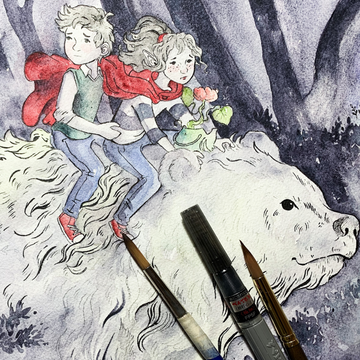 What is contrast? It’s a common term used in creative, artistic circles. Contrast, when it comes to art, is achieved when opposite elements are arranged together.
What is contrast? It’s a common term used in creative, artistic circles. Contrast, when it comes to art, is achieved when opposite elements are arranged together.
Although these elements might be opposites, their arrangement can still be appealing. The contrast in art might even be considered the golden rule of art.
It’s a powerful tool that every creative can use to create stunning work, and it’s a method none of us should disregard.
What are a few of the common artful contrasts? The most obvious is dark and light, but there are others as well: warm and cool colours; hard and soft shapes; colours that are opposite each other on the colour wheel; textures; sizes, etc.
Using these opposites comprehensively in our work is a powerful asset, and contrasts work well in any art form: fine art, graphic design, illustration, painting, digital art, contemporary art, impressionism, sculpting, etc. The key is knowing how to utilise it well.
What Can Contrast be Used For?

Even though it seems a little counterintuitive to think that contrasts and opposites can work together in a way that the eye perceives as aesthetically pleasing, these opposites do work well when placed together appropriately. It can create a unique beauty.
Contrast can be used to tell a story, to create a better composition, to create a sense of unease, to create a sense of peace, to draw attention to the focal point, to clarify what is taking place—the list is endless; but it is clear that contrast is a powerful tool.
The Basics of Contrast in Art

The important thing is not to feel overwhelmed. Contrasts are incredibly simple: it’s how we use them that makes the biggest visual impact.
They’re as simple as black ink on white paper, but don’t let the simplicity be underwhelming. Contrast packs a punch.
Use Contrast to Build a Strong Composition: tonal contrast can be used to direct the eyes of our audiences to see things the way they’re meant to be seen.
It can also be used to clarify what is taking place, as well as define foreground, middle-ground, and background.
Even if our compositions are well arranged, the final piece might not have a great enough impact if we don’t use tonal contrast to clarify.
It’s a common mistake to use similar tones, without any variation, in our creative work. There are light tones, mid-tones, and dark tones.
It’s important to use these all with as much intention as is possible. The easiest way to grasp this concept is to create a simple sketch (with fore, middle, and backgrounds) and blocking in the shapes with graphite (shades of grey).
Before filling it in, think critically on how using the three tones could be used to enhance the piece. We go more in-depth with this in our blog post on Tonal Values and Contrast for Beginners.
There’s no one magical formula, but there is an endless array of what can be accomplished with these three tonal sets.
We can use dark tones for the foreground, light tones for the middle-ground (where our focal point is), and mid-tones for the background.
A dark focal point on a light middle-ground pulls out the focal point, while the dark foreground draws the viewer’s eyes into the central character. And this is just one variation of limitless possibilities.
Small tonal sketches are a good way to practice using contrast before committing it to our paintings.
And even though tonal sketches work in shades of grey, it is easy to use the premise in colour (i.e. dark colour on light colour).
And it is a formula that works whether we are painting in monochrome or using a full-colour pallet.
In addition to this, what we know of colour theory can enhance our tonal contrast even more. Warms and cools? Contrasting colours? Light and shadow?
We only have a play around with the options to hit on what suits our piece the best, and more often than not all of these rules can be tied in together to create a cohesive painting.
Lighting and shadow work hand in hand with warm and cool colours, for example.
Contrast Can Draw the Viewer’s Eyes into the Focal Point: when we create a work of art, it’s absolutely important that we don’t lose sight of our focal point and what we are trying to tell our audiences.
When we first create a piece, we can be tempted to add too much and overwhelm the piece with too much information, or important information gets lost because our tones are all too similar.
Contrast is what distinguishes an object from an object, helps tell a clearer story, and allows viewers to see what is happening.
While it is something that was discussed briefly above, it cannot be overstated how important it is to have a clear focal point.
The best way to set apart the central figure in our paintings or illustrations is in contrast. It’s possible to use any rules of contrast to do this, whether it’s light on dark; the contrast of colours; warm and cool, etc.
Any of these methods can pull out and show viewers what they are supposed to be looking at.

In the end, the best way to get a handle on contrast is to practice it, combine the rules, and to use contrast to its full extent in our work. Begin practicing with simple, tonal sketches.
Colour keys are even a fantastic way to begin learning to use contrasts with colour or lighting.
Practice it as often as needed, and create a multiplicity of the same sketch to explore as many contrasting possibilities as possible.
The right formula might not come right away, which is why it’s important to explore all the options afforded to us.
Study the work of other illustrators, graphic designers, artists, and masters in art history. How did they use contrast to embellish their work?
These rules of contrast, while simple, are capable of giving our art a great sense of awe and power. It takes a piece that might be mediocre and makes it genius.



2 comments
Who created the artwork?
You information on The Power of Contrast is clear and very informative. I’m a beginner in watercolors but have done numerous sketches in graphite and color pencil therefore very much familiar with ‘tonal values’. Watercolours will prove to be challenge but looking forward. Thank you.
———
Etchr Lab replied:
So happy this blog was helpful for you, Sandra! 🧡